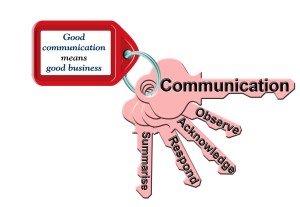Telephone Techniques
The telephone is often the first point of contact with your client, therefore it is very important to handle this introduction to yourself and your services well. It is the first place where you will practice the skills known as selling.
There are six points to consider:
* Be Ready * Be Quick to Respond * Use both your Own and your Caller’s Name * Have a Bright and Cheery Disposition * Be Polite and * Be Accurate
Be Ready
There are seven key points to consider in being ready. These very much depend on your own level of personal development as to how well you will do.
- Listen so that you may respond and be helpful.
- Have a genuine concern for people.
- Develop a positive attitude towards selling.
- Use an outgoing manner.
- Have an active (rather than passive) style.
- Be non-discriminatory in your attitude about people (incl. sex, race, creed, colour)
- Treat others as you would like to be treated.
In working out how other people tick you only need to consider how it is that you like to be treated. You’ll get further with people if you treat them this way, and even further again if you treat them better than they expect to be treated.
One of the prime motivators in people is the search for recognition. After all, isn’t one of the reasons you have decided that this form of self-employment is better than working for an employer because you lacked the recognition you deserved. Haven’t you at some stage of your career felt this? And have you noticed that you work better for the clients who tell you that you’ve done a wonderful job rather than those who constantly criticise your work? Well, consider this – your clients will be more responsive to you if you treat them well too.
Be Quick to Respond
By being quick to respond, people subliminally receive the message that you are ready to do business with them. Also, if you are quick to respond to any messages that are left for you people will doubt you less. Their impression will be that you are committed to looking after them. In order to be really prompt you also need to answer the phone before it rings five times whenever you can answer the phone. This gives the caller enough time to prepare their questions to you after they have dialed your number and not so much time that they feel that you will be neglectful in other areas of business as well.
Use both your Own and your Caller’s Name
Greet your caller with “Good Morning, Good Afternoon, Good Evening” followed by “this is” and then your own name. You may also add, “How may I help you?” but this is not completely necessary.
By doing this you show the caller that you’re a person – not an object. You are also showing the caller that you want to be friendly towards them. In response people will generally treat you with equal friendliness and respect.
When you use your own name it encourages the other person to trade names with you, with the underlying assumption that the personal touch really counts. Also, you can sometimes prevent bad tempered people taking their fury out on you if they are not happy with your work. By the way that you answer the phone they may realise that you are a person just as much as they are, and this will tend to slow them down a little. And last but certainly not least, use the caller’s name as often as you possibly can. There’s nothing more pleasant to the caller’s ear than the sound of their name being used sincerely. Be personal.
Have a Bright and Cheery Disposition
It is important to replace negative phrases with positive ones. This all starts with being aware of the words you are using when you speak to people. The picture that you should aim to paint for your caller is that your operation is a CAN-DO one. “Yes, I can do that for you Mrs Jones. When would you like it done – this week or next?”
Phrases such as “I’m sorry, I can’t do that for you” should be replaced with “I’ll make sure that gets done for you Mrs Jones. I’m not able to do it myself, but I know someone who can. So we’ll get back to you shortly”. Or “I can’t do that until Friday” needs to be replaced with “I can do that on Friday for you Mrs Jones”.
As you can see, the picture that you will be creating will be a positive one where your client experiences as little resistance as possible from you towards their requests. There will always be the occasion where you either do not have the skills, knowledge or products necessary to help your caller, but they can still experience a positive outcome from calling you when provided with the information they need in order to get what they want. In seeking to satisfy the caller’s needs you keep the door open for a time when you can help them.
Always be positive, and never be sarcastic to your caller.
 Be Polite
Be Polite
In being polite you need to listen. Listening is part of communicating, and good communication skills need to be developed in order to make a total success of your business. Try the O.A.R.S. principle:
Observe – observe the way in which your caller communicates to you and match their communication if you can. Slow down the speed at which you talk if you are talking faster than your caller is. Speed up your sentences if you are talking more slowly.
Acknowledge – acknowledge your caller so that they are aware that they are getting their message across to you. Using words like “right; OK; yes; Uhuh” etc show that you are listening. Because the caller cannot see you over the telephone they cannot observe your body language to know what you are doing. So you must keep your connection with them through regular acknowledgement.
Respond – in responding to your caller they are giving the message that what they have said to you has been understood e.g. “I see what you mean”, “I know what you are saying”, “I’d feel like that too.”
Summarise – Summarising what has been said to you is beneficial to both you and the caller. This way you can iron out any misunderstandings that may occur, plus you re-iterate what the caller has said to you. You could use phrases such as “The way I understand it is like this…..” or “So what you are saying is…..”
If you happen to be accessing information that the caller needs via your computer and it is taking a very long time to provide you with what you want, explain this to the caller e.g. “I’m just opening the file right now……it’s busy thinking….ah, there it goes, it’s only just opened up for me now. Let’s see what I can do for you Mrs Jones.” Or “that’s going to take two minutes for me to organise, will that be OK?” Try to give the caller the option of saying yes.
Be Accurate
And finally, make sure everything is right – give the perfect answer!

